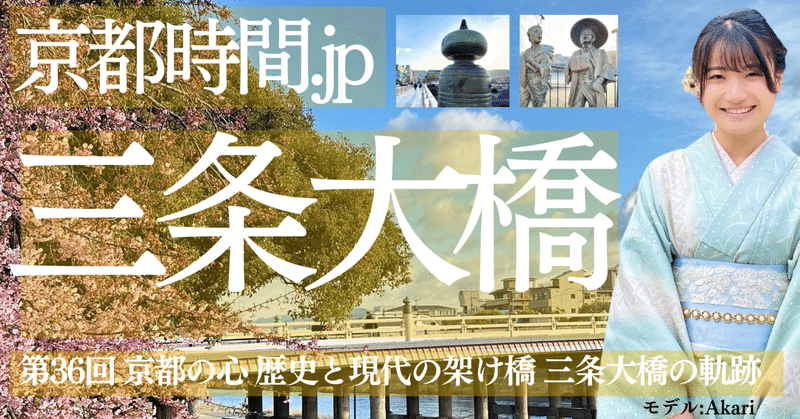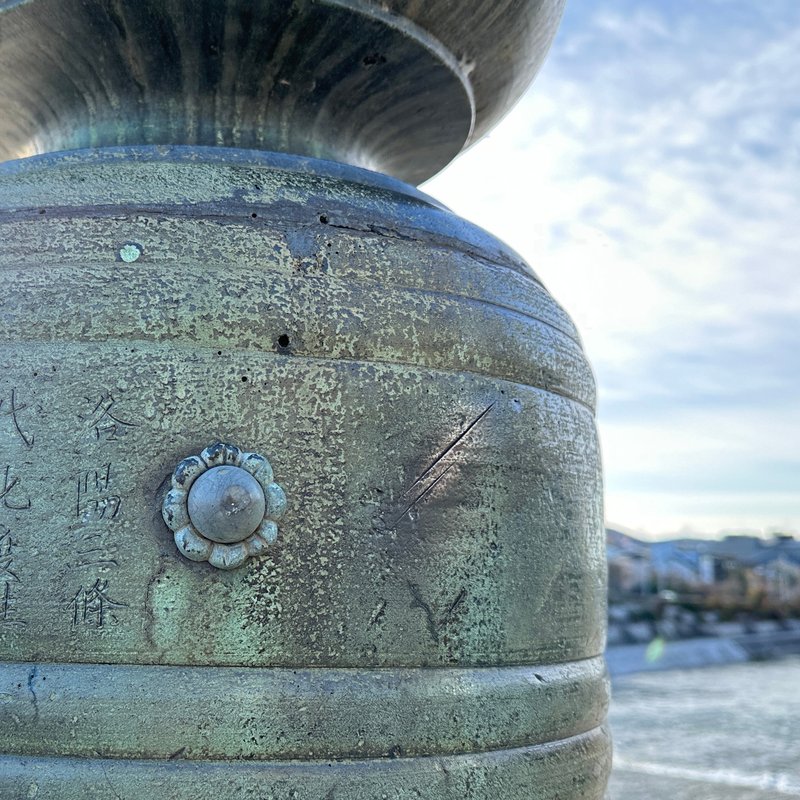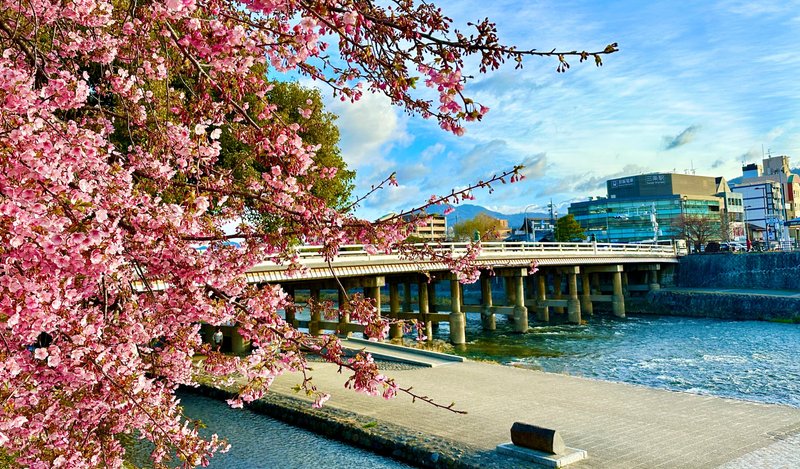
【京都時間.jp】第36回 京都の心 歴史と現代の架け橋 三条大橋の軌跡
美しい鴨川の上に優雅に架かる三条大橋は、京都の歴史と文化の深さを象徴する存在です。室町時代からその最初の礎を築き、豊臣秀吉の手によって大改修されたこの橋は、激動の戦国時代を経て、数々の重要な歴史的瞬間の証人となりました。



天正17年(1589年)には、技術の粋を集めた石柱の橋への改修が行われ、これにより三条大橋は、京都だけでなく日本の歴史においても重要な役割を担うことになります。その役割は江戸時代に入るとさらに拡がり、東海道五十三次の西の起点となり、幕府直轄の公儀橋として、日本全国の交通の要所としての重要性を増していきました。

この橋は、元禄、明治、大正と各時代にわたる架け替えを経て、1950年(昭和25年)には現在の鋼単純H型の橋が完成し、技術の進歩と共に数度にわたる架け替えは、機能性と耐久性を重視しつつも、伝統的な美しさを保持するデザインが採用されています。そして近年、2022年から2024年にかけて欄干の更新工事が行われるなど、伝統と現代性が融合したアプローチによる補修・修景工事が行われ、その美しさと歴史的価値の保存に向けた努力が続けられています。

三条大橋の文化的な重要性は、十返舎一九による滑稽本『東海道中膝栗毛』に登場する弥次郎兵衛と喜多八の像が設置されていることからも窺えます。この作品は日本の文学史において重要な位置を占め、旅の安全を祈願する目的で設置されたこの像は、物語と実際の歴史が融合し、京都の文化的な深みをさらに深めるものです。

また、橋の西から数えて2つ目の擬宝珠には、新選組の活動や幕末期の動乱を物語る池田屋事件の際に付けられたとされる刀傷の痕が今も残っており、貴重な証拠となっています。


さらに、三条大橋はスポーツ史においても重要な位置を占めています。1917年(大正6年)には、三条大橋から東京の上野不忍池間で初めて駅伝が開催され、これは日本初の駅伝競走「東海道駅伝徒歩競走」のスタート地点としても知られています。このイベントは、東海道五十三次の「駅」にちなんで名付けられ、日本のスポーツ史において重要な位置を占めることになりました。


周囲の風景と共に、三条大橋は京都の文化と歴史の中心地として、特別な雰囲気を醸し出しています。春には桜が満開になり、夏には川床で涼を取る人々の姿が、秋には紅葉が鴨川沿いを彩り、冬には雪化粧した京都の静寂が訪れます。これら四季折々の風情は、この地域の特別な魅力を作り出しています。

三条大橋はただの構造物ではありません。それは、京都の歴史、文化、美を象徴し、世代を超えてその価値を伝え続ける生きた博物館のような存在です。橋を渡るたびに、訪れる人々は京都の豊かな過去と希望に満ちた未来を感じ取ることができます。不変の姿で変わりゆく時代の中で常に新しい価値を創造し続ける三条大橋は、過去と現在、そして未来を繋ぐ京都の象徴として、世界に開かれた文化都市の位置を確固たるものにしています。この橋とその周辺地域は、豊かな歴史と文化を今に伝える貴重な場所であり、訪れるすべての人々にとって忘れがたい魅力的なスポットです。ぜひ訪れてほしい場所の一つです。

The Sanjo Ohashi Bridge, elegantly spanning the beautiful Kamo River, symbolizes the depth of history and culture in Kyoto. From its initial foundations in the Muromachi period, through a major renovation under the direction of Toyotomi Hideyoshi, this bridge has witnessed numerous pivotal historical moments, especially towards the end of the tumultuous Sengoku period. Its role expanded further into the Edo period, becoming a crucial juncture for Japan's nationwide traffic as the western starting point of the Tokaido, underscoring its significance.
In 1589, under Toyotomi Hideyoshi's orders, the bridge was reconstructed with the pinnacle of the period's engineering into a stone-pillared structure by Masuda Nagamori. From this point forward, Sanjo Ohashi assumed an integral role not just within Kyoto but in Japan's history at large. During the Edo period, it served as the western starting point of the fifty-three stations of the Tokaido, positioned as a bridge directly governed by the shogunate. Through renovations across various eras including Genroku, Meiji, and Taisho periods, the current steel simple H-shaped bridge was completed in 1950.
In recent years, from 2022 to 2024, railing renewal works were carried out, showcasing a dedication to local materials such as "Miyako Soma Wood" from Kyoto city. The bridge's design reflects Kyoto's traditional aesthetics, with meticulous attention paid to the renewal of sidewalks and guardrails.
Notably, the bridge features statues of Yaji and Kita from the comical book "Tokaidochu Hizakurige" by Jippensha Ikku, illustrating their adventurous journey from Edo to Ise Shrine, Kyoto, and Osaka. This work holds a significant place in Japan's literary history, and the statues, made from stones sourced from Kurama, known for the legendary hero Minamoto no Yoshitsune, merge narrative with actual history, deepening the cultural layers of Kyoto.
Moreover, the second giboshi (decorative bulb) from the west end of the bridge bears sword marks attributed to the Ikedaya Incident, serving as a precious testament to the activities of the Shinsengumi and the tumultuous Bakumatsu period. In 1917, the bridge became the starting point for Japan's first ekiden (relay race) between Sanjo Ohashi and Ueno Shinobazu Pond in Tokyo, named after the stations of the Tokaido, marking its important place in Japan's sports history as well.
Sanjo Ohashi, along with its surrounding scenery, creates a unique atmosphere as the cultural and historical heart of Kyoto. In spring, the cherry blossoms are in full bloom; in summer, people cool off on the riverbanks; in autumn, the maples color the banks of the Kamo River; and in winter, the snow-capped quietude of Kyoto descends. These seasonal beauties, alongside the riverbanks, historic machiya houses, ancient temples, and shrines, craft a unique charm for the area.
Sanjo Ohashi is more than just a structure; it is a living museum that embodies the history, culture, and beauty of Kyoto, conveying its value across generations. Crossing the bridge, visitors can sense Kyoto's rich past and hopeful future. Constantly creating new value within changing times, Sanjo Ohashi stands as a symbol of Kyoto, bridging the past, present, and future, cementing its place in the world as a cultural city. This bridge and its surrounding area remain a precious site, conveying rich history and culture to the present, making it an unforgettable attraction for all who visit. It is indeed a must-visit location.
この記事が気に入ったらサポートをしてみませんか?
